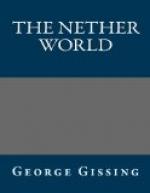Sidney Kirkwood had a lodging in Tysoe Street, Clerkenwell. It is a short street, which, like so many in London, begins reputably and degenerates in its latter half. The cleaner end leads into Wilmington Square, which consists of decently depressing houses, occupied in the main, as the lower windows and front-doors indicate, by watchmakers, working jewellers, and craftsmen of allied pursuits. The open space, grateful in this neighbourhood, is laid out as a garden, with trees, beds, and walks. Near the iron gate, which, for certain hours in the day, gives admission, is a painted notice informing the public that, by the grace of the Marquis of Northampton, they may here take their ease on condition of good behaviour; to children is addressed a distinct warning that ’This is not a playing ground.’ From his window Sidney had a good view of the Square. The house in which he lived was of two storeys; a brass plate on the door showed the inscription, ‘Hodgson, Dial Painter.’ The window on the ground-floor was arched, as in the other dwellings at this end of the street, and within stood an artistic arrangement of wax fruit under a glass shade, supported by a heavy volume of Biblical appearance. The upper storey was graced with a small iron balcony, on which straggled a few flower-pots. However, the exterior of this abode was, by comparison, promising; the curtains and blinds were clean, the step was washed and whitened, the brass plate shone, the panes of glass had at all events acquaintance with a duster. A few yards in the direction away from the Square, and Tysoe Street falls under the dominion of dry-rot.
It was not until he set forth to go to work next morning that Sidney called to mind his conversation with Jane. That the child should have missed by five minutes a meeting with someone who perchance had the will and the power to befriend her, seemed to him, in his present mood, merely an illustration of a vice inherent in the nature of things. He determined to look in at the public-house of which she had spoken, and hear for himself what manner of man had made inquiries for people named Snowdon. The name was not a common one; it was worth while to spend a hope or two on the chance of doing Jane a kindness. Her look and voice when he bade her be of good courage had touched him. In his rejected state, he felt that it was pleasant to earn gratitude even from so humble a being as the Peckovers’ drudge.
His workshop, it has been mentioned, was in St. John’s Square. Of all areas in London thus defined, this Square of St. John is probably the most irregular in outline. It is cut in two by Clerkenwell Road, and the buildings which compose it form such a number of recesses, of abortive streets, of shadowed alleys, that from no point of the Square can anything like a general view of its totality be obtained. The exit from it on the south side is by St. John’s Lane, at the entrance to which stands a survival from a buried world—the embattled and windowed




